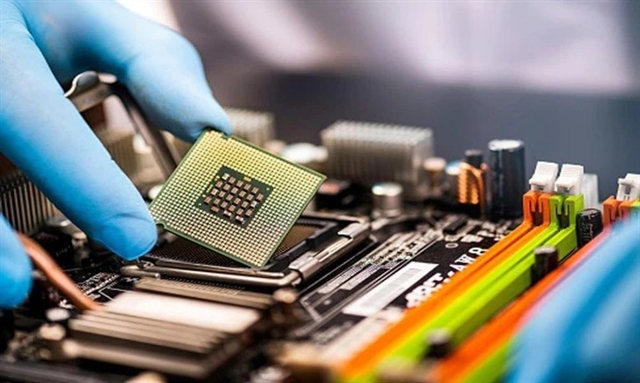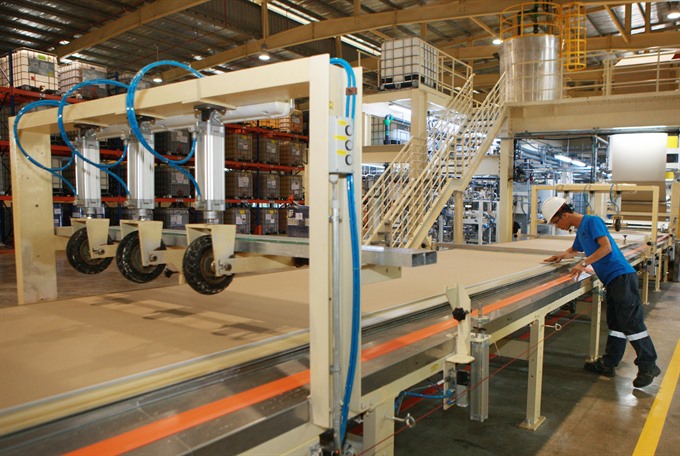 Economy
Economy

Việt Nam’s GDP in the second quarter of this year is forecast to expand 5.6 per cent or 6.27 per cent, depending on two scenarios, expert said.
 |
| Production line at the Knauf Vietnam Co Ltd’s new gypsumboard plant in the northern port city of Hải Phòng. — VNA/VNS Photo Lâm Khánh |
HÀ NỘI — Việt Nam’s GDP in the second quarter of this year is forecast to expand 5.6 per cent or 6.27 per cent, depending on two scenarios, expert said.
Đặng Đức Anh, director of the National Centre for Socio-Economic Information and Forecast (NCEIF)’s analysis and forecast department, said this at a discussion on the country’s macro-economic growth forecast, held in Hà Nội on Wednesday.
Under the first scenario of 5.6 per cent GDP growth, Anh said that processing and manufacturing industries in Q2 would grow higher than in the first quarter, and the slowdown of the mining industry would be lower than that in Q1. The foreign exchange rate would be relatively stable and credit growth would continue to rise in Q2, Anh said, adding that disbursement of State investment capital would be also higher than Q1.
In the second scenario, the GDP would grow 6.27 per cent in Q2, owing to the recovery of the mining sector, with exploitation output at the same level as 2016; the disbursement of State investment capital would be strong; and the processing and manufacturing industry would grow higher than it did during the same period last year.
The Q2 GDP in 2016 expanded 5.57 per cent.
At the discussion, experts pointed out that Việt Nam’s economy would be influenced significantly by global scenarios such as the recovery of world trade and economy, oil price fluctuations and development of the global finance market in the wake of the US Federal Reserve’s interest rate hike.
In the domestic market, business confidence of local enterprises is stable, experts said. More than 50 per cent of the firms expect their number of business contracts in Q2 to be higher than Q1.
Investment by private and foreign direct investment firms is also expected to rise in Q2 owing to the Government’s efforts to improve the business climate.
To meet the Government’s GDP growth target of 6.7 per cent in 2017, NCEIF director Nguyễn Thị Mai Thu suggested that the State work to further stabilise the macro economy to be able to create more confidence among investors and the business community. It will also be necessary to speed up the disbursement of State investment capital and Government bonds, she added.
The Government should also closely monitor the implementation of tasks raised in its Resolution 19/2016/NQ-CP on improving the business climate and the national competitive edge, and on the action programme on economic restructuring in the 2017-20 period.
Though exports are forecast to rise significantly in the next few months, expert Cấn Văn Lực recommended that export firms be active in material resources.
According to the General Statistics Office (GSO), Việt Nam’s GDP growth in the first quarter of 2017 was only 5.1 per cent, lower than the 6.72 per cent and 5.48 per cent growth rates during the same period in 2015 and 2016, respectively.
Hà Quang Tuyến, director of GSO’s national account department, said there are three reasons why the growth rate has been weaker than forecast in Q1.
First, the lingering effects of drought and saltwater intrusion from last year led to a sharp drop in rice production, which led to a contraction in the plant cultivation sub-sector.
Second, industrial growth slowed to 4.1 per cent against 7.4 per cent recorded in the first three months of 2016, mainly the result of a manufacturing slowdown. Notably, electronic production shrank 1 per cent compared to the 11.3 per cent growth last year because of Samsung’s poor performance.
Third, the mining sector has been hit by the Government’s attempts to balance growth and the exploitation of natural resources, as part of its drive to restructure the economy and renew the growth model. — VNS




